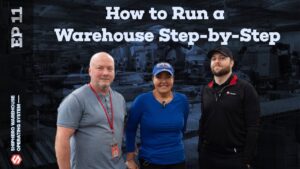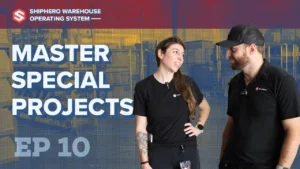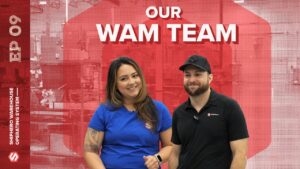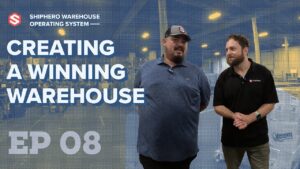Video Transcript
"Well, I got the job done."
"Yeah, but we didn't bill for it.
Yeah, we made the customer happy, but it wasn't
necessarily the best thing."
In a warehouse, it's not just picking and
packing.
We've got what we call special projects, but
it's special projects or anything that doesn't
fit into your normal pick, pack and ship flow.
If you're a 3PL, you're charging your clients
typically by hour for your special projects.
So you'll have a team that works with special
projects, you'll track those hours, you'll
bill your client for those hours, in theory.
In reality, oftentimes the hours billed is
a lot less than the hours clocked, which isn't
because anyone's doing anything malicious,
but the people are working on special projects.
They're focused on getting that work done,
not necessarily tracking well what projects
they're working on.
We had that problem in our own buildings.
We solve it using our WorkforceHero feature,
which is our labor force management that runs
across the warehouse.
I'm going to work today with Rob McFaul, who's
our VP of Fulfillment Operations, who's going
to talk us through WorkforceHero to make sure
that the hours we bill for special projects
match the hours actually worked on those projects
so we're not losing revenue that we earn,
and also how we track to make sure that the
amount of hours in payroll for the people
assigned to special projects also matches
what we're billed so that there's not a significant
amount of time off task or unbilled time.
Because the way the economics of special projects
will typically work is you pay an average
of $20 an hour, you charge your customer $45
an hour, but you have an admin overhead management
fees and costs associated with it.
So it's profitable, but it's not super profitable.
So you need to make sure that you don't have
any time off task, any more leakage than the
bare minimum so that you're profitable in
your special projects.
So Rob, why don't you start by talking us
through how an individual associate who's
working on special projects tracks which project
they're working on.
Okay.
So essentially, when an associate shows up
to work, they're going to walk up to a kiosk
like this.
This kiosk will allow them, with a badge,
to clock into their job.
Very simple.
No pin codes, no memorization.
This can also be associated with a door lock.
So they just have this one badge.
They walk into the facility and they're going
to use this to clock in, that would start
their pay for that day.
What we did with special projects specifically
is allowed them to very easily scan into a
job that then gets tracked through WorkforceHero
to what Aaron said and how it's easily tracked.
Then it's very simple.
No one has to write things down, no one has
to pull up an Excel spreadsheet and try to
remember who did what when a week later when
the manager's trying to figure out what they
did.
They're just empowered to do this.
And we'll show you later how easy it is for
the manager or supervisor to track, to make
sure that it's actually being tracked properly.
So I'm going to take my badge, I'm going to
scan it.
It's going to tell me, "Hey, you're here."
So, now I have the option to select a job,
go to lunch, finish my ship, or go to a specific
job.
That job could be picking, packing, whatever,
but in the case of special projects, I have
this QR code.
This QR code is associated on the backend
with a specific project.
All they need to know is they need this for
the job.
They could have a stack of them and be rotating
through.
Oh, yeah, I let it time out.
Let's get this back on.
Okay.
So now, I just scan that and now it says I
joined that job.
The job name is arbitrary.
We use Digits to back it up as like a job
ID, but you could use the name, you could
use any kind of thing you want.
And the good thing about this is if the job
has not been created in a WorkforceHero yet,
we put the digits SP- in front of the job
name, that tells the system that it's a special
project and will auto create the job on the
first scan so that no one has to go in and
create the job within ShipHero.
Any challenges with managing the special projects
team?
And you've been doing this for a lot of years.
What have you learned over those years to
make special projects better?
The challenges that obviously led us to this
is that tracking, that manual, someone has
to write, "Okay, three people start on a special
project."
Someone has to write that down on a piece
of paper.
What I hear from managers and I've heard over
the years is that's their last priority.
Their first priority is to calm the issue,
which is get the job done.
So they're focused on that.
They've got 10 people that just showed up,
they're temp workers, whatever.
They're unloading a truck, they could be wrapping
something, anything that's billable, and then
they forget about that part.
So it's like, "Well, I got the job done."
"Yeah, but we didn't bill for it.
Yeah, we made the customer happy, but it wasn't
necessarily the best thing."
So what we needed to do is integrate a system
where that manual tracking was removed and
that oversight could be done by a manager,
and you'll see the system later for that.
So that challenge is now averted by using
this system where they don't have to manually
track.
All they have to do is make sure that the
employees who show up to work are now clocked
into that job, including the manager or anybody
involved with that project, and it will track
all of it.
Okay.
And my understanding is you can actually connect
this to 3PL billing so that the customer's
automatically billed as part of that special
project for the labor component.
There's other components, typically the pallet
fee or if you have a per item fee, but the
hours will automatically pull from WorkforceHero
to 3PL billing so that the client is automatically
billed for the hours.
So one less task.
They're going to use a function within ShipHero
called Work Orders, which will allow you to
bill the special project, whether it's a special
project or what we would call a work order
assembly order.
And in there is where the job will be created
in ShipHero, and there'll be ad hoc charges.
So in 3PL billing, we use ad hoc charges to
bill for stuff.
So not only will it pull in the special project
hours, but any box charges, label or pallets
can all be added as ad hoc charges to the
work order.
And then that will be connected to 3PL billing
and pulled in as a full ad hoc charge based
on all the components, including hours of
that job.
So when you think about the people side, how
do you decide which people should go on special
projects versus picking or packing or sorting?
The decision would be based on a little bit
more of experience in the warehouse because
there's more diversity in it.
So I can start someone as a picker or a packer
fairly easily.
First day, there's a few sets of instructions
like push this button, do this, scan that,
very simple instruction.
So it's a good place to start people, but
we can also start people on special projects
assembly where you have someone who's leading
the task, leading the job, but then you have
a bunch of people that would just be assembling
things in a very factory-like way or assembly
fashion.
So that would be determined on day.
But the leaders, the people that are running
it, they have to go into the computer, they
have to understand a little bit about some
of our software to be able to run it as opposed
to a picker packer.
So maybe an experienced packer who gets good
at what they do or shows that they understand
our software better could be moved to special
project.
So it sounds like you need a ton of experience
for the special projects lead, lots of warehouse
experience, know how to bill the pallet.
And then for the individuals below them working
on it, that's often could be temps or new
hires who just have to be able to follow a
simple set of instructions.
Absolutely.
And as long as a lot of the project is just
that manual labor aspect, but that one person,
those two people that need to work that flow,
and now that person, that lead doesn't have
to try to remember how many hours all these
people work.
All they say is, "Here's your code, here's
your badge.
Make sure you keep this code with you for
that job.
When you're done that job, hand them back.
I'll give you a new one for our next project
and I'll direct you."
So that labor management part is very simple
and very low energy.
The barrier to entry is quite low to track
it very well.
One thing that I'm really excited that we
changed recently was a problem that we used
to have, from what I recall, is projects would
show up on the floor, they would be incomplete,
the floor could not complete it.
They didn't necessarily get back to the person
who created the project quickly.
And then we'd have projects sitting idle for
a significant period of time on work.
And I believe what we're doing right now is
the team, the remote team, so it's not a team
in the building, make sure that the projects
are fully complete and then hence the building,
just the next few tasks that they're supposed
to work on, and then it is their job to make
sure that nothing gets to the warehouse floor
that the warehouse floor cannot do.
Yeah.
Anything that's non-actionable does not show
up.
So there's no noise for the warehouse.
What we try to do is make sure that the noise
that they see or the interruptions or the
distractions are minimized.
So if their job or our system, if their job's
not done or if they have a blocker, that'll
go back to our remote team, that job will
move off their project board and they'll move
on to something else that's ready to work
on basically.
And the remote team will look at it, determine
the blockers, solve them, and then put it
back on their job board.
And we do that with the ShipHero to monday.com
integration, right?
Yes.
Yes.
That's how it goes back.
So we use monday.com for that project management
piece and future state with ShipHero, we're
going to use ShipHero more and more and more
to actually manage that whole flow even with
the remote team right within ShipHero.
At the moment, in a work order or a special
projects, you can upload attachments, BOLs,
weights, DIMs, box information, all the things
that are part of that project, right into
ShipHero.
So I've talked to the development team and
we're certainly working towards a fully functional
system right within the software where that
project can be managed remotely and onsite
with ShipHero.
All right.
And when you think about the people in this
building, what percent of them are working
on special projects?
It's usually a low percent depending on the
B2B component in that building.
Most of the warehouses have a team of anywhere
from two to four people that work on special
projects, and that's their main function.
What will happen is a very large special projects
comes in, you can see behind me, they're working
on pulling all these boxes for a client and
they're probably going to bring in extra people.
And the great thing about that component is
the labor management of it, you see your pickers
are slow or something like that, you can pull
them over to special projects, put them on
the billable hours by handing them a QR code.
Every single person in the building has a
ShipHero QR code on their badge to scan to
the kiosk to clock in.
So it's a fully integrated system.
So WorkforceHero is a fully integrated system
with ShipHero as a WMS, something that I've
always wanted, because in a warehouse we have
our time clock, whatever that is, and there's
various companies that provide time clock
clock in abilities, but it's never been connected
with the WMS.
So what we did in ShipHero was we put them
together so that activities within the warehouse
could be also tracked in the time or your
pay system.
So that makes it that fully integrated solution
so you can see what pickers are doing, idle
time, time off task, as Aaron said.
It auto-detects their activity.
So in this case, there's no auto-detection,
so we're scanning it.
But if I start picking in the app, automatically
I moved into that job of picking or packing
or inventory, replenishment of all the jobs
within are auto recognized.
It also tells you when they're not doing something,
time off task.
So that integrated system is, I've never seen
it before, and it makes managers have less
time worrying about that admin stuff with
employees and more time trying to make sure
that their job gets done.
As you think about the profitability of running
a 3PL, because you're charging for time and
labor in special projects, and this is just
a microcosm of running the whole building,
the only way you're losing money on special
projects is not counting time and time off
task.
And it happens all the time.
Every warehouse has leakage to time off task.
If you're not tracking it, you don't know
how bad it is and you cannot fix it.
So we found, as the system gets rolled out
to more buildings, the percent of hours billed
increases dramatically just because as you
track it, people will actually enter the data
and you do a much better job of capturing
the revenue that you as a business owner have
earned.
So your customers owe it to you, just got
to make sure you're billing them for it.
I want to talk about one last thing before
we go, which is non-English speakers.
So we're here in Florida, but every building
from the south through the north has a significant
percentage of non-English speakers in the
warehouse.
So how do you think about non-English speakers
and making sure that they've got the tools
they need to do the work, both in special
projects and throughout the warehouse?
So this has obviously been a pain point for
us for years.
So once again, the ShipHero engineers came
up with a solution, with Aaron's lead, and
basically we have made it so that a user within
ShipHero, you can set their native language
where it's Mexico Spanish or it could be Spain
Spanish or French Canadian versus France,
different language.
And what it will do is when they scan their
badge, it'll come up in Spanish or whatever
language they want.
So this has been a pain point.
Even though the tasks are somewhat simple,
there are instructions given to pickers, packers,
special projects workers that are not complicated,
but if they can't read them, they sometimes
ignore them.
So now, if you set their language, when they're
interacting with the system, it's going to
show them the communication in their language.
Yeah, that's something we're working on, continuing
to roll out more languages across more parts
of the system because A, it reduces mistakes,
but B, most importantly for me, I think it
increases retention of those associates as
they see that they're respected, that we're
putting the effort towards accommodating their
native language, they're more likely to stick.
And we have a lot of really hardworking, dedicated
employees that do not speak English.
And by giving them the tools they need to
do their job really well, we have a higher
retention with them.
So something I'm really proud of.
This was just a recent feature that we turned
on here, and I saw one of the employees who
I've known for years walk up and scan her
badge and her face just lit up because this
was the first time she was actually able to
read the screen properly.
So that was a great feature.
Just continually trying to work with the people,
work with the software, the engineers, WorkforceHero
is a work in progress.
There's still more features to be added.
I have more ideas, but its basic functionality
now can be fully utilized as a payroll system
and as a tracker of activities within the
warehouse.
So it's a dual purpose there.
The point is not to cover payroll just so
that you have one less piece of software,
it's so that by having it together, that's
how you know that the hours worked match the
hours paid.
Because you've probably kitted and shipped
out of here tens or hundreds of thousands
of special projects over the years, any last
thoughts about what someone who's starting
up a 3PL should be thinking about running
a warehouse really well for special projects?
Well, now that we have this software, it's
really a matter of execution and having the
organization, the way we do it with a team,
whether it's remote or not, if you're running
your own warehouse and you're trying to make
sure it works, having that point person who
sets the jobs all up, they're already being
set up automatically, so it's a very simple
process.
And then I think the main thing for whoever's
doing that is we have a dashboard, which you're
going to see probably in a screen cutaway.
It is a nice dashboard that's going to show
you what jobs are clocked into for how long.
And so you can manage that very easily on
a daily basis to do a sanity check, end of
the day, quick look on the dashboard, make
sure that the projects that you expected to
be billing are being billed, because you still
rely on the employee to scan.
So there is that point of failure potentially
with that.
So that's why the dashboard is there, to give
you that extra bit of work.
And then being efficient, touching things
once, the standard warehouse stuff, just making
sure that when people are pulling stuff, they're
putting them in locations, they're putting
them in spots where they know where they are
so that there's just no confusion.
Keep it simple.
Yeah, I'll add accountability and just making
sure that you're connecting all the dots so
that you're hitting your SLAs for your customers
and you're getting billed for it.
It is a process.
As long as you're following that process,
you'll do well.
But if you ignore it and you just assume it
runs itself, you'll often have gaps that can
be really costly.
So, I would encourage everyone who's running
a warehouse to spend a couple of days thinking
about their special projects process and flow,
make sure there's one person owning what gets
done, make sure that it's complete before
it gets to the warehouse and that you're tracking
the hours.
Once you have that system in place, you'll
find that your revenue capture is higher than
it was before.
Just why I'm so adamant about making sure
that at the end of the day you're checking,
because very easily someone could stay clocked
in by mistake, they forgot to clock out, and
then you're overbilling.
You don't want to overbill your clients either.
They don't like that very much.
So because this is your source of truth, meaning
this tracking system, if it's incorrectly
tracked because of the human element, you
need to make sure that you're checking both
ends of those transactions so that when someone's
out of the building but still "billing hours,"
you don't want that to happen.
And just as a final point, even if you're
a 3PL with four or five employees, this is
just as important to be able to track that
time.
It's just one less thing you have to think
about.
And even if that person is full-time doing
a job, there's multiple projects.
So if you have projects that you're doing
or you have billable hours, or you just want
to know how long someone is doing something
in a specified task, whether it, I don't know,
changing the lights, whatever it is, you could
create a special project or a time tracking
job for that person to scan in and it can
be tracked.
So even in a small warehouse is very beneficial.
As you can tell, we're really passionate about
building the best software in the world for
helping you manage your special projects,
everything from making sure the job is done
to making sure you're capturing the money.
But please add any comments.
I'm sure we're missing things.
How can we make this better?
Whether you're a ShipHero user or not, just
add a comment to the video and we'll respond.
Thank you.



